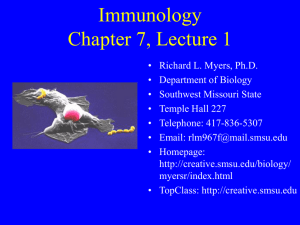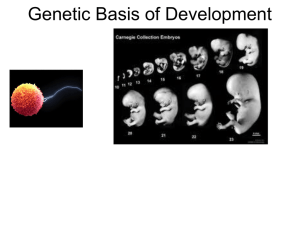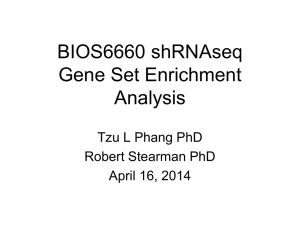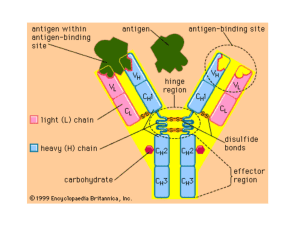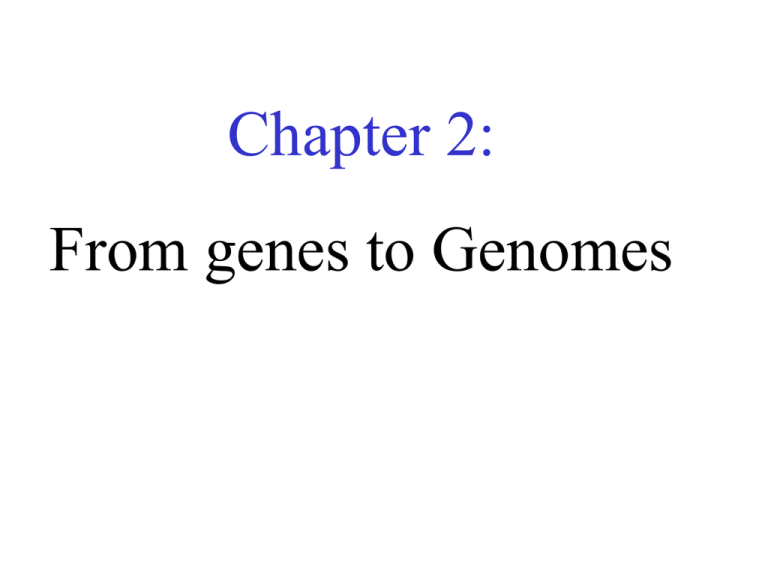
Chapter 2:
From genes to Genomes
2.1 Introduction
Mapping:
Genetic (or linkage) map: recombination frequencies
Restriction map: length of DNA
Ultimate map: sequence of the DNA
overlapping fragments of DNA:
2.2 Genes can be mapped by
restriction cleavage
5kb
Figure 2.1
DNA can be
cleaved by
restriction enzymes
into fragments that
can be separated by
gel electrophoresis.
Figure 2.2 Double digests define the cleavage
positions of one enzyme with regard to the other.
Figure 2.3
A restriction
map can be
constructed
by relating
the Afragments and
B-fragments
through the
overlaps seen
with double
digest
fragments.
Figure 2.4
When
restriction
fragments
are identified
by their
possession
of a labeled
end, each
fragment
directly shows the distance of a cutting site from the
end. Successive fragments increase in length by the
distance between adjacent restriction sites.
Figure 2.5 A restriction map is a linear sequence of
sites separated by defined distances on DNA. The
map identifies the sites cleaved by enzymes A and B,
as defined by the individual fragments produced by
the single and double digests.
2.3 How variable are individual
genomes?
genetic polymorphism: multiple alleles coexist at
a locus
single nucleotide polymorphism (SNP): a single
nucleotide change between alleles
Figure 2.6 A point mutation that affects a restriction site
is detected by a difference in restriction fragments.
restriction fragment length polymorphism (RFLP):
difference in restriction maps between two individuals
Figure 2.7
Restriction
site
polymorph
isms are
inherited
according
to
Mendelian
rules. Four
alleles for
a
restriction marker are found in all possible pairwise
combinations, and segregate independently at each generation.
Photograph kindly provided by Ray White.
Figure 2.8 A restriction
polymorphism can be
used as a genetic marker
to measure recombination
distance from a
phenotypic marker (such
as eye color). The figure
simplifies the situation by
showing only the DNA
bands corresponding to
the allele of the other
genome in a diploid.
Figure 2.9
If a restriction
marker is
associated with
a phenotypic
characteristic,
the restriction
site must be
located near the
gene
responsible for
the phenotype.
The mutation changing the band that is common in normal
people into the band that is common in patients is very closely
linked to the disease gene.
2.4 Eukaryotic genes are often
interrupted
Figure 2.10
Interrupted genes
are expressed via
a precursor RNA.
Introns are
removed when
the exons are
spliced together.
The mRNA has
only the
sequences of the
exons
2.5 Organization of interrupted
genes may be conserved
Figure 2.11 Comparison of the restriction maps of
cDNA and genomic DNA for mouse b-globin shows
that the gene has two introns that are not present in the
cDNA. The exons can be aligned exactly between
cDNA and gene.
Figure 2.12 An intron is a sequence present in the gene
but absent from the mRNA (here shown in terms of
the cDNA sequence). The reading frame is indicated
by the alternating open and shaded blocks; note that all
three possible reading frames are blocked by
termination codons in the intron.
Figure 2.13 All functional globin genes have an
interrupted structure with three exons. The
lengths indicated in the figure apply to the
mammalian b-globin genes.
Figure 2.14 Mammalian genes for DHFR have the
same relative organization of rather short exons and
very long introns, but vary extensively in the lengths
of corresponding introns.
2.6 Exon sequences are conserved
but introns vary
Figure 2.15
The sequences of the
mouse amaj and amin
globin genes are
closely related in
coding regions, but
differ in the flanking
regions and large
intron. Data kindly
provided by Philip
Leder.
2.7 Genes can be isolated by the
conservation of exons
Figure 2.16
Chromosome
walking is
accomplished
by successive
hybridizations
between
overlapping
genomic
clones.
Figure 2.17 A zoo blot
with a probe from the
human Y chromosomal
gene zfy identifies crosshybridizing fragments on
the sex chromosomes of
other mammals and birds.
There is one reacting
fragment on the Y
chromosome and another
on the X chromosome.
Data kindly provided by
Dabid Page.
Figure 2.18
The gene involved in
Duchenne muscular
dystrophy has been
tracked down by
chromosome mapping
and walking to a region
in which deletions can
be identified with the
occurrence of the
disease.
Figure 2.19
The Duchene
muscular dystrophy
gene has been
characterized by zoo
blotting, cDNA
hybridization,
genomic
hybridization, and
identification of the
protein.
Figure 2.20
A special splicing
vector is used for
exon trapping. If
an exon is present
in the genomic
fragment, its
sequence will be
recovered in the
cytoplasmic RNA,
but if the genomic
fragment consists
solely of an intron,
2.8 Genes show a wide distribution
of sizes
Figure 2.21
Exons coding
for proteins
are usually
short.
Figure 2.22 Introns in vertebrate genes
range from very short to very long.
Figure 2.23
Most genes are
uninterrupted in
yeast, but most
genes are
interrupted in
flies and
mammals.
(Uninterrupted
genes have only
1 exon, and are
totaled in the
leftmost column.)
Figure 2.24 Yeast
genes are small, but
genes in flies and
mammals have a
dispersed
distribution
extending to very
large sizes.
Figure 3.1
DNA content of the
haploid genome is
related to the
morphological
complexity of lower
eukaryotes, but
varies extensively
among the higher
eukaryotes. The
range of DNA
values within a
phylum is indicated
by the shaded area.
2.9 Some DNA sequences code
for more than one protein
Overlapping gene
Figure 2.25 Two proteins can be generated from a
single gene by starting (or terminating)
expression at different points.
Figure 2.26 Two genes may share the same
sequence by reading the DNA in different frames
Figure 2.27
Alternative
splicing uses
the same premRNA to
generate
mRNAs that
have different
combinations
of exons.
Figure 2.28 Alternative splicing generates the a
and b variants of troponin T.
2.10 How did interrupted genes
evolve?
Two models for interrupted genes evolving
• introns early model : introns have always been an
integral part of the gene. Genes originated as
interrupted structures, and those without introns have
lost them in the course of evolution.
• introns late model: the ancestral protein-coding units
consisted of uninterrupted sequences of DNA. Introns
were subsequently inserted into them.
Figure 2.29 Immunoglobulin light chains and heavy chains
are coded by genes whose structures (in their expressed
forms) correspond with the distinct domains in the protein.
Each protein domain
corresponds to an exon;
introns are numbered 1-5.
Figure 2.30
The LDL receptor
gene consists of
18 exons, some of
which are related
to EGF precursor
and some to the
C9 blood
complement gene.
Triangles mark
the positions of introns. Only some of the introns in
the region related to EGF precursor are identical in
position to those in the EGF gene.
Figure 2.20
A special splicing
vector is used for
exon trapping. If
an exon is present
in the genomic
fragment, its
sequence will be
recovered in the
cytoplasmic RNA,
but if the genomic
fragment consists
solely of an intron,
Figure 2.13 All functional globin genes have an
interrupted structure with three exons. The lengths
indicated in the figure apply to the mammalian bglobin genes.
Figure 2.31 The exon structure of globin genes
corresponds with protein function, but leghemoglobin
has an extra intron in the central domain.
Figure 2.32 The rat insulin gene with one intron
evolved by losing an intron from an ancestor with
two interruptions.
Figure 2.33 Actin genes vary widely in their
organization. The sites of introns are indicated in
purple; the number identifies the codon interrupted
by the intron.
2.11 Summary
Genes and genomes can be mapped by the
use of overlapping restriction fragments.
Ultimately this can be extended into a
sequence. Restriction sites can be used as
genetic markers. The existence of
polymorphisms (RFLPs) allows linkage maps
to be constructed using restriction fragments.
All types of eukaryotic genomes contain
interrupted genes. The proportion of
interrupted genes is low in yeasts and
increases in the lower eukaryotes; few genes
are uninterrupted in higher eukaryotes
Introns are found in all classes of eukaryotic
genes. The structure of the interrupted gene
is the same in all tissues, exons are joined
together in RNA in the same order as their
organization in DNA, and the introns usually
have no coding function. Introns are removed
from RNA by splicing. Some genes are
expressed by alternative splicing patterns, in
which a particular sequence is removed as an
intron in some situations, but retained as an
exon in others.
Positions of introns are conserved when
the organization of homologous genes is
compared between species. Intron
sequences vary, and may even be
unrelated, although exon sequences remain
well related. The conservation of exons can
be used to isolate related genes in different
species.
The size of a gene is determined primarily
by the lengths of its introns. Introns become
larger early in the higher eukaryotes, when
gene sizes therefore increase significantly.
The range of gene sizes in mammals is
generally from 1~100 kb, but it is possible to
have even larger genes; the longest known
case is dystrophin at 2000 kb.
Some genes share only some of their exons
with other genes, suggesting that they have
been assembled by addition of exons
representing individual modules of the protein.
Such modules may have been incorporated
into a variety of different proteins. The idea that
genes have been assembled by accretion of
exons implies that introns were present in
genes of primitive organisms. Some of the
relationships between homologous genes can
be explained by loss of introns from the
primordial genes, with different introns being
lost in different lines of descent.






